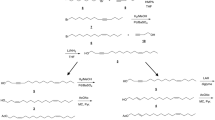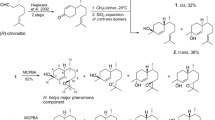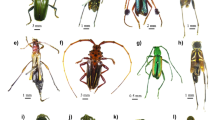Abstract
Several hymenopterous parasites ofScolytus multistriatus are attracted to components of its aggregation pheromone, multilure.Cheiropachus colon, Entedon leucogramma, Dendrosoter protuberans, Spathius benefactor, andCerocephala eccoptogastri are attracted in various degrees to multilure, its components (multistriatin, 4-methyl-3-heptanol, and cubebene), and component combinations.C. colon was trapped in greatest numbers, yet was usually less numerous thanE. leucogramma andD. protuberans in the study area. Impact of traps onC. colon may conceivably be reduced by multistriatin content in baits and/or by withholding traps untilS. multistriatus flight begins.
Similar content being viewed by others
References
Cuthbert, R.A., andPeacock, J.W. 1978. Response of the elm bark beetle,Scolytus multistriatus (Coleoptera: Scolytidae), to component mixtures and doses of the pheromone, multilure.J. Chem. Ecol. 4:363–373.
Gore, W.E., Pearce, G.T., Lanier, G.N., Simeone, J.B., Silverstein, R.M., Peacock, J.W., andCuthbert, R.A. 1977. Aggregation attractant of the European elm bark beetle,Scolytus multistriatus: Production of individual components and related aggregation behavior.J. Chem. Ecol. 3:429–446.
Grissell, E.E. 1981. The identity of nearcticCerocephala Westwood (Hymenoptera: Pteromalidae).Proc. Entomol. Soc. Wash. 83:620–624.
Kennedy, B.H. 1970.Dendrosoter protuberant (Hymenoptera: Braconidae), an introduced larval parasite ofScolytus multistriatus.Ann. Entomol. Soc. Am. 63:351–358.
Kennedy, B.H. 1974. Net reproduction ofDendrosoter protuberans (Nees),Spathius benefactor Matthews andCheiropachus colon (L.) reared on larvae ofScolytus multistriatus (Marsham).Proc. North Cent. Branch Entomol. Soc. Am. 29:178–179.
Kennedy, B.H. 1979. The effect of multilure on parasites of the European elm bark beetle,Scolytus multistriatus.Bull. Entomol. Soc. Am. 25:116–118.
Lanier, G.N., Silverstein, R.M., andPeacock, J.W. 1976. Attractant pheromone of the European elm bark beetle (Scolytus multistriatus): Isolation, identification, synthesis, and utilization studies, pp. 149–175,in J.F. Anderson and H.K. Kaya (eds.). Perspectives in Forest Entomology. Academic Press, New York.
Lanier, G.N., Gore, W.E., Pearce, G.T., Peacock, J.W., andSilverstein, R.M. 1977. Response of the European elm bark beetle,Scolytus multistriatus (Coleoptera: Scolytidae) to isomers and components of its pheromone.J. Chem. Ecol. 3:1–8.
Pearce, G.T., Gore, W.E., Silverstein, R.M., Peacock, J.W., Cuthbert, R.A., Lanier, G.N., andSimeone, J. B. 1975. Chemical attractants for the smaller European elm bark beetleScolytus multistriatus (Coleoptera: Scolytidae).J. Chem. Ecol. 1:115–124.
Author information
Authors and Affiliations
Rights and permissions
About this article
Cite this article
Kennedy, B.H. Effect of multilure and its components on parasites ofScolytus multistriatus (Coleoptera: Scolytidae). J Chem Ecol 10, 373–385 (1984). https://doi.org/10.1007/BF00987864
Received:
Revised:
Issue Date:
DOI: https://doi.org/10.1007/BF00987864




